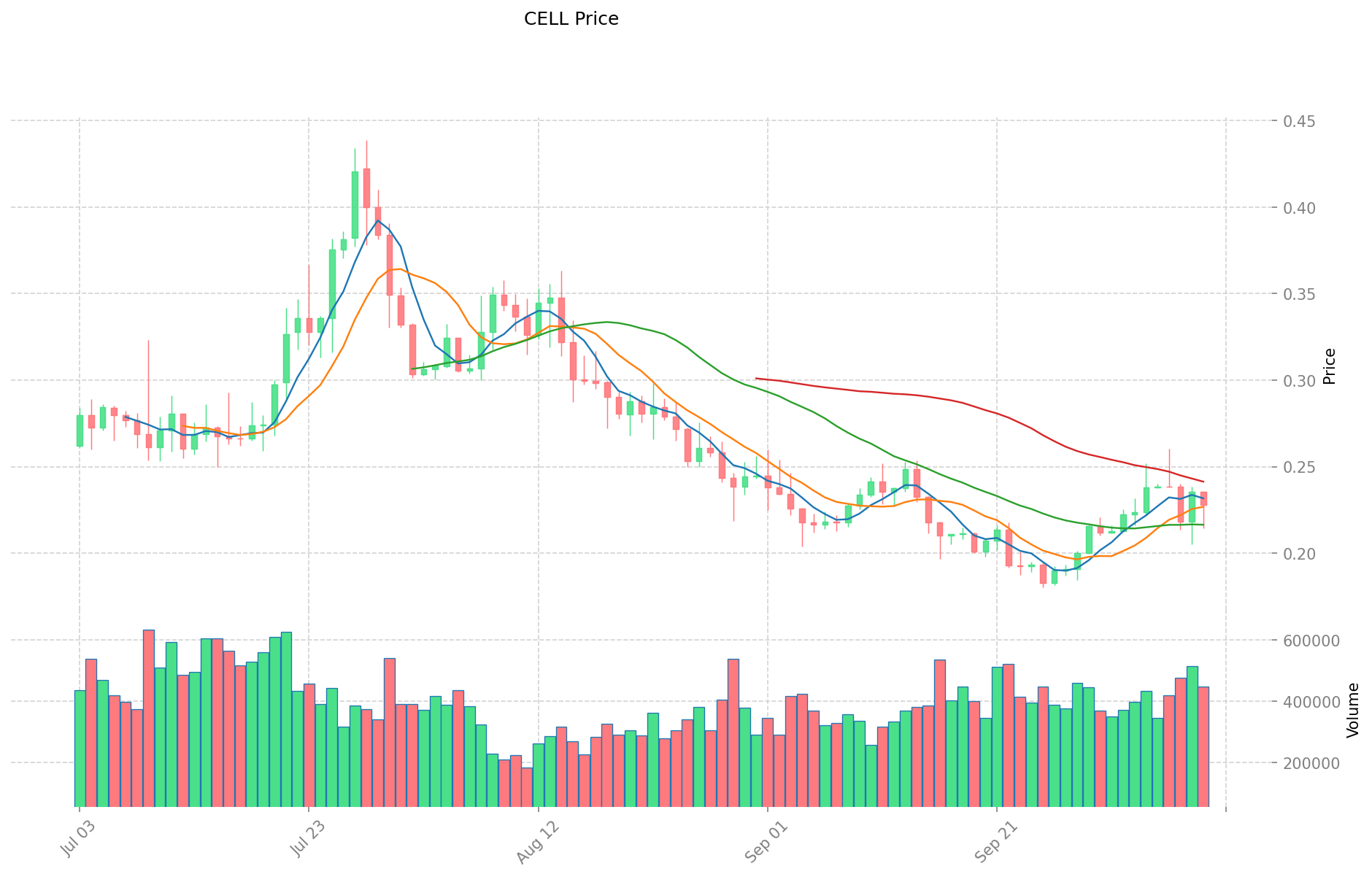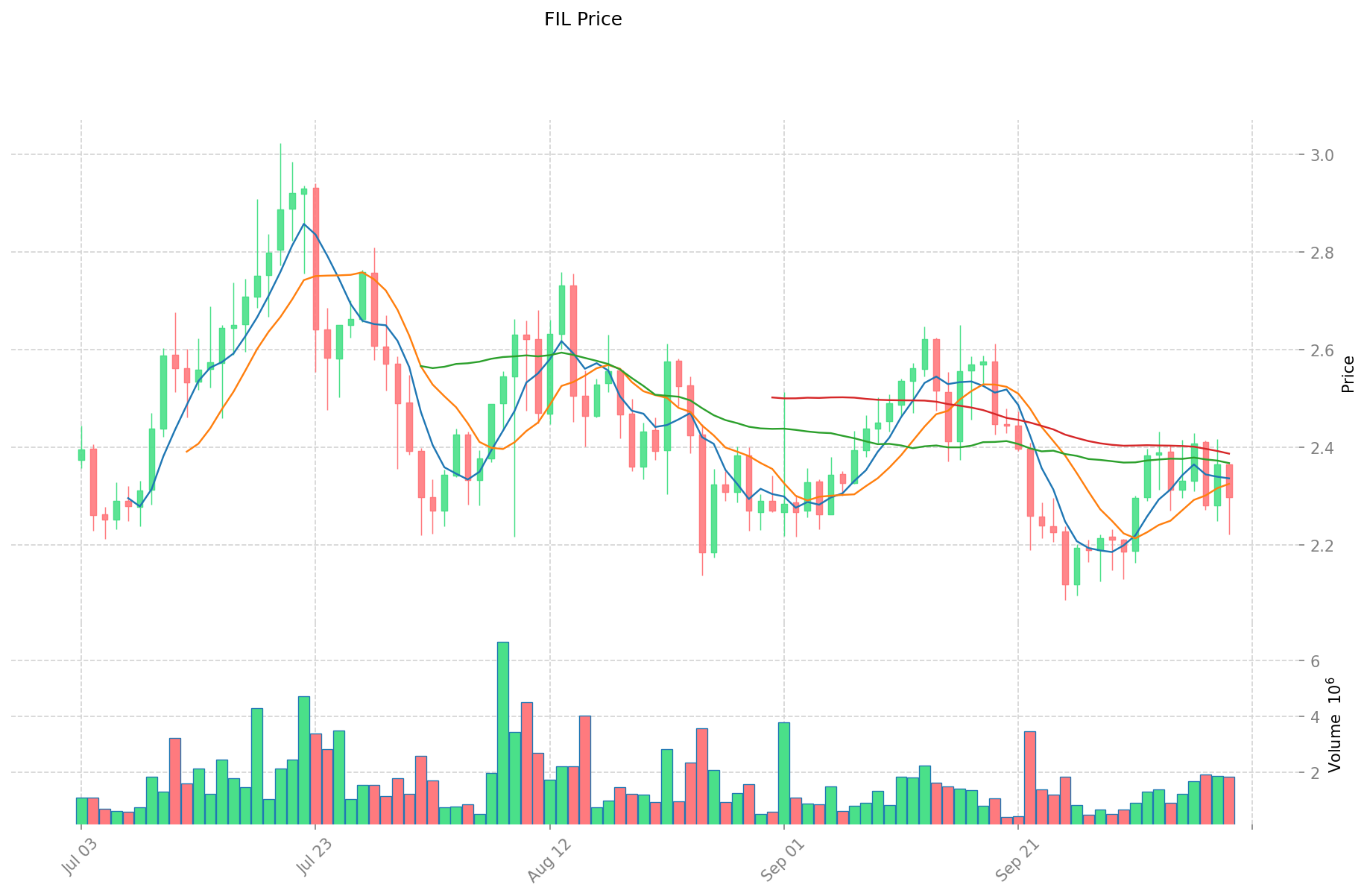CELL vs FIL: The Battle of Storage Tokens in the Decentralized Data Economy
Introduction: Investment Comparison of CELL vs FIL
In the cryptocurrency market, CELL vs FIL comparison has always been a topic investors can't ignore. The two not only have significant differences in market cap ranking, application scenarios, and price performance, but also represent different crypto asset positioning.
Cellframe Network (CELL): Since its launch in 2021, it has gained market recognition for its focus on quantum-resistant first-layer network and secure cross-chain transactions.
Filecoin(IPFS) (FIL): Since its introduction in 2020, it has been hailed as a decentralized storage network, becoming one of the cryptocurrencies with high global trading volume and market capitalization.
This article will comprehensively analyze the investment value comparison between CELL and FIL, focusing on historical price trends, supply mechanisms, institutional adoption, technological ecosystems, and future predictions, attempting to answer the question investors care about most:
"Which is the better buy right now?"
I. Price History Comparison and Current Market Status
CELL (Coin A) and FIL (Coin B) Historical Price Trends
- 2021: CELL reached its all-time high of $7.21 on March 25, 2021, likely due to increased interest in quantum-resistant blockchain technologies.
- 2021: FIL hit its all-time high of $236.84 on April 1, 2021, possibly influenced by growing demand for decentralized storage solutions.
- Comparative analysis: In the market cycle since their all-time highs, CELL has fallen from $7.21 to a current price of $0.2284, while FIL has dropped from $236.84 to $2.295.
Current Market Situation (2025-10-10)
- CELL current price: $0.2284
- FIL current price: $2.295
- 24-hour trading volume: CELL $101,234.71 vs FIL $4,103,242.03
- Market Sentiment Index (Fear & Greed Index): 64 (Greed)
Click to view real-time prices:
- View CELL current price Market Price
- View FIL current price Market Price


II. Core Factors Affecting Investment Value of CELL vs FIL
Supply Mechanism Comparison (Tokenomics)
- CELL: Supply capped at 10 billion tokens, with 60% allocated to storage providers as mining rewards
- FIL: Maximum supply of 2 billion tokens, with 55% allocated to miners and 15% to protocol labs
- 📌 Historical pattern: Limited supply models for both tokens create scarcity, potentially driving price appreciation during increased network adoption phases.
Institutional Adoption and Market Applications
- Institutional holdings: FIL has gained more institutional traction with backing from major VCs including Sequoia Capital, Andreessen Horowitz, and Union Square Ventures
- Enterprise adoption: FIL demonstrates broader adoption in enterprise storage solutions, while CELL is positioning itself in AI data storage and computation markets
- Regulatory stance: Both projects operate in regulatory gray areas across jurisdictions, with FIL having a longer compliance history
Technical Development and Ecosystem Building
- CELL technical upgrades: Network has integrated AI computation capabilities with distributed storage, focusing on decentralized AI applications
- FIL technical development: Implementation of Filecoin Virtual Machine (FVM) enabling smart contracts and programmable storage
- Ecosystem comparison: FIL has a more mature ecosystem with established storage providers and integration partners, while CELL is building specialized infrastructure for AI data processing and storage
Macroeconomic and Market Cycles
- Inflation performance: Both position themselves as digital commodities with utility value in data storage, potentially offering inflation protection
- Monetary policy impact: Both tokens show correlation with broader crypto market reactions to monetary tightening
- Geopolitical factors: Increasing data sovereignty concerns globally may benefit decentralized storage networks III. 2025-2030 Price Prediction: CELL vs FIL
Short-term Prediction (2025)
- CELL: Conservative $0.13969 - $0.229 | Optimistic $0.229 - $0.27251
- FIL: Conservative $1.91315 - $2.305 | Optimistic $2.305 - $2.55855
Mid-term Prediction (2027)
- CELL may enter a growth phase, with an estimated price range of $0.207173781 - $0.263443203
- FIL may enter a growth phase, with an estimated price range of $1.933261125 - $2.88700328
- Key drivers: Institutional capital inflow, ETFs, ecosystem development
Long-term Prediction (2030)
- CELL: Base scenario $0.300819207425625 - $0.3850485855048 | Optimistic scenario $0.3850485855048+
- FIL: Base scenario $3.628823928159 - $3.88284160313013 | Optimistic scenario $3.88284160313013+
Disclaimer: This analysis is based on historical data and current market trends. Cryptocurrency markets are highly volatile and unpredictable. This information should not be considered as financial advice. Always conduct your own research before making any investment decisions.
CELL:
| 年份 | 预测最高价 | 预测平均价格 | 预测最低价 | 涨跌幅 |
|---|---|---|---|---|
| 2025 | 0.27251 | 0.229 | 0.13969 | 0 |
| 2026 | 0.2607852 | 0.250755 | 0.1955889 | 9 |
| 2027 | 0.263443203 | 0.2557701 | 0.207173781 | 11 |
| 2028 | 0.27518305059 | 0.2596066515 | 0.142783658325 | 13 |
| 2029 | 0.33424356380625 | 0.267394851045 | 0.17915455020015 | 17 |
| 2030 | 0.3850485855048 | 0.300819207425625 | 0.204557061049425 | 31 |
FIL:
| 年份 | 预测最高价 | 预测平均价格 | 预测最低价 | 涨跌幅 |
|---|---|---|---|---|
| 2025 | 2.55855 | 2.305 | 1.91315 | 0 |
| 2026 | 2.723588 | 2.431775 | 2.31018625 | 5 |
| 2027 | 2.88700328 | 2.5776815 | 1.933261125 | 12 |
| 2028 | 3.6340153787 | 2.73234239 | 1.8579928252 | 19 |
| 2029 | 4.074468971968 | 3.18317888435 | 2.801197418228 | 38 |
| 2030 | 3.88284160313013 | 3.628823928159 | 2.61275322827448 | 58 |
IV. Investment Strategy Comparison: CELL vs FIL
Long-term vs Short-term Investment Strategies
- CELL: Suitable for investors focused on quantum-resistant blockchain and AI data storage potential
- FIL: Suitable for investors seeking established decentralized storage solutions and broader ecosystem adoption
Risk Management and Asset Allocation
- Conservative investors: CELL: 30% vs FIL: 70%
- Aggressive investors: CELL: 60% vs FIL: 40%
- Hedging tools: Stablecoin allocation, options, cross-currency portfolios
V. Potential Risk Comparison
Market Risks
- CELL: Higher volatility due to lower market cap and trading volume
- FIL: Susceptible to broader crypto market trends and competition in decentralized storage
Technical Risks
- CELL: Scalability, network stability
- FIL: Mining power concentration, security vulnerabilities
Regulatory Risks
- Global regulatory policies may impact both differently, with FIL potentially facing more scrutiny due to its larger market presence
VI. Conclusion: Which Is the Better Buy?
📌 Investment Value Summary:
- CELL advantages: Quantum-resistant technology, AI data storage focus, potential for higher growth
- FIL advantages: Established ecosystem, higher institutional adoption, proven track record in decentralized storage
✅ Investment Advice:
- Novice investors: Consider a higher allocation to FIL for its established market presence
- Experienced investors: Balanced approach with both CELL and FIL, adjusting based on risk tolerance
- Institutional investors: Evaluate CELL for long-term potential, maintain significant FIL exposure for established decentralized storage play
⚠️ Risk Warning: Cryptocurrency markets are highly volatile. This article does not constitute investment advice. None
FAQ
Q1: What are the main differences between CELL and FIL? A: CELL focuses on quantum-resistant blockchain and AI data storage, while FIL is an established decentralized storage network. CELL has a lower market cap and trading volume, while FIL has broader institutional adoption and a more mature ecosystem.
Q2: Which coin has performed better historically? A: FIL reached a higher all-time high of $236.84 in April 2021, compared to CELL's all-time high of $7.21 in March 2021. However, both have experienced significant price declines since their peaks.
Q3: What are the supply mechanisms for CELL and FIL? A: CELL has a supply cap of 10 billion tokens, with 60% allocated to storage providers. FIL has a maximum supply of 2 billion tokens, with 55% allocated to miners and 15% to protocol labs.
Q4: How do institutional adoptions compare between CELL and FIL? A: FIL has gained more institutional traction, with backing from major venture capital firms like Sequoia Capital and Andreessen Horowitz. CELL has less institutional adoption but is positioning itself in AI data storage markets.
Q5: What are the long-term price predictions for CELL and FIL? A: By 2030, CELL's base scenario price range is predicted to be $0.300819207425625 - $0.3850485855048, while FIL's base scenario range is $3.628823928159 - $3.88284160313013.
Q6: What are the main risks associated with investing in CELL and FIL? A: CELL faces higher volatility due to lower market cap and trading volume, as well as technical risks related to scalability and network stability. FIL is susceptible to broader crypto market trends, competition in decentralized storage, and potential regulatory scrutiny due to its larger market presence.
Q7: Which coin is recommended for different types of investors? A: Novice investors might consider a higher allocation to FIL for its established market presence. Experienced investors could take a balanced approach with both CELL and FIL. Institutional investors may evaluate CELL for long-term potential while maintaining significant FIL exposure for established decentralized storage play.
Share
Content